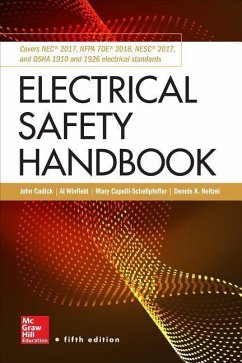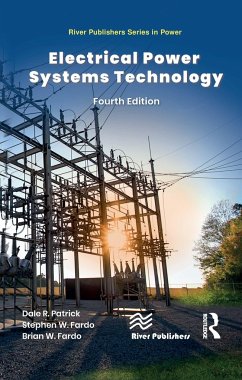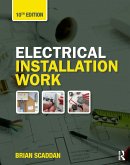- Gebundenes Buch
- Merkliste
- Auf die Merkliste
- Bewerten Bewerten
- Teilen
- Produkt teilen
- Produkterinnerung
- Produkterinnerung
Publisher's Note: Products purchased from Third Party sellers are not guaranteed by the publisher for quality, authenticity, or access to any online entitlements included with the product. On-the-job electrical safety essentials-thoroughly revised for the latest procedures and standards This fully updated electrical safety guide is a practical, illustrated source of life-saving information designed for specific work environments. The book has been fully revised and expanded to conform to every current major electrical standard, including NEC, NESC, NFPA70E, IEEE 1584, and OSHA. Written by…mehr
Andere Kunden interessierten sich auch für
![Electrical Power Systems Technology Electrical Power Systems Technology]() Dale R. PatrickElectrical Power Systems Technology186,99 €
Dale R. PatrickElectrical Power Systems Technology186,99 €![Electrical Installation Work Electrical Installation Work]() Brian ScaddanElectrical Installation Work93,99 €
Brian ScaddanElectrical Installation Work93,99 €![Electrical Installation Work Electrical Installation Work]() Brian ScaddanElectrical Installation Work174,99 €
Brian ScaddanElectrical Installation Work174,99 €![The Invisible Rainbow The Invisible Rainbow]() Arthur FirstenbergThe Invisible Rainbow27,99 €
Arthur FirstenbergThe Invisible Rainbow27,99 €![Modern Wiring Practice Modern Wiring Practice]() W E StewardModern Wiring Practice97,99 €
W E StewardModern Wiring Practice97,99 €![Spark Spark]() Timothy J. JorgensenSpark28,99 €
Timothy J. JorgensenSpark28,99 €![Electrical Craft Principles Electrical Craft Principles]() John WhitfieldElectrical Craft Principles51,99 €
John WhitfieldElectrical Craft Principles51,99 €-
-
-
Publisher's Note: Products purchased from Third Party sellers are not guaranteed by the publisher for quality, authenticity, or access to any online entitlements included with the product. On-the-job electrical safety essentials-thoroughly revised for the latest procedures and standards This fully updated electrical safety guide is a practical, illustrated source of life-saving information designed for specific work environments. The book has been fully revised and expanded to conform to every current major electrical standard, including NEC, NESC, NFPA70E, IEEE 1584, and OSHA. Written by experts in electrical operations, maintenance, engineering, construction, and safety, Electrical Safety Handbook, Fifth Edition provides the most up-to-date safety strategies in an easy-to-use format. The book delivers complete details on electrical hazards, safety equipment, management, training, regulatory and legal requirements, accident prevention, and much more. You will find new sections on electrical grounding, heat transfer theory as it relates to the human body, and the medical aspects of electrical trauma. .Contains comprehensive coverage of every subject on the exam .Includes updated electrical grounding concepts and applications .Written by a team of electrical safety experts
Hinweis: Dieser Artikel kann nur an eine deutsche Lieferadresse ausgeliefert werden.
Hinweis: Dieser Artikel kann nur an eine deutsche Lieferadresse ausgeliefert werden.
Produktdetails
- Produktdetails
- Verlag: McGraw-Hill Education
- 5 ed
- Seitenzahl: 688
- Erscheinungstermin: 11. Juli 2019
- Englisch
- Abmessung: 239mm x 191mm x 38mm
- Gewicht: 1178g
- ISBN-13: 9781260134858
- ISBN-10: 1260134857
- Artikelnr.: 52421942
- Herstellerkennzeichnung
- Libri GmbH
- Europaallee 1
- 36244 Bad Hersfeld
- gpsr@libri.de
- Verlag: McGraw-Hill Education
- 5 ed
- Seitenzahl: 688
- Erscheinungstermin: 11. Juli 2019
- Englisch
- Abmessung: 239mm x 191mm x 38mm
- Gewicht: 1178g
- ISBN-13: 9781260134858
- ISBN-10: 1260134857
- Artikelnr.: 52421942
- Herstellerkennzeichnung
- Libri GmbH
- Europaallee 1
- 36244 Bad Hersfeld
- gpsr@libri.de
Dennis K. Neitzel, C.P.E, is a certified plant engineer and has 33 years of experience in the electrical field. During eight years with the U.S. Air Force he served consecutively as an electrician, electrical shift supervisor, quality control inspector, and evaluator. Subsequent civilian employment included positions at the Idaho National Engineering Laboratory and at Westinghouse Idaho Nuclear, where he advanced to senior project engineer. Mr. Neitzel went to AVO International Training Institute in 1986 and has progressed from senior training specialist to Institute director. He has served as a principal committee member for NFPA 70E standards since 1992 and is currently working on the revision of OSHA regulations. Mr. Neitzel has published articles on electrical safety, holds a master's degree in electrical engineering applied sciences, and is a certified electrical inspector.
Foreword
Preface
Acknowledgments
Chapter 1. Hazards of Electricity
Introduction
Hazard Analysis
Shock
Description
Influencing Factors
Arc
Definition and Description
Arc Energy Release
Arc Energy
Arc Energy Input
Arcing Voltage
Arc Surface Area
Incident Energy
Arc Burns
Blast
Affected Body Parts
General
Skin
The Nervous System
Muscular System
The Heart
The Pulmonary System
Summary of Causes-Injury and Death
Shock Effect
Arc-Flash Effect
Causes of Injury
Causes of Death
Protective Strategies
References
Chapter 2. Basic Physics of Electrical Hazards
Introduction
Electromagnetism
Introduction
The Four Fundamental Forces (Interactions) of Nature
The Electromagnetic Spectrum
Electrical Properties of Materials
Conductors
Nonconductors
Physics Considerations in Electrical Fault Conditions
Risks
Bolted Fault
Arcing Fault
Review of Foundational Approaches to Interpreting Arcing Phenomena
Summary
References
Chapter 3. Electrical Safety Equipment
Introduction
General Inspection and Testing Requirements for Electrical Safety Equipment
Arc-Flash and Thermal Protection
A Note on When to Use Thermal Protective Clothing
Thermal Performance Evaluation
Clothing Materials
Non-Arc-Rated Materials
Arc-Rated Materials
Work Clothing
Arc-Flash Suits
Head, Eye, and Hand Protection
Head and Eye Protection
Hard Hats
Safety Glasses, Goggles, and Face Shields
Rubber Insulating Equipment
Rubber Gloves
Rubber Mats
Rubber Blankets
Rubber Covers
Line Hose
Rubber Sleeves
In-Service Inspection and Periodic Testing of Rubber Goods
Hot Sticks
Description and Application
When to Use
How to Use
Testing Requirements
Insulated Tools
Description and Application
When to Use
How to Use and Care For
Barriers and Signs
Barrier Tape
Signs
When and How to Use
Safety Tags, Locks, and Locking Devices
Safety Tags
Locks and Multiple-Lock Devices
Locking Devices
When and Where to Use Lockout-Tagout
Voltage-Measuring Instruments
Safety Voltage Measurement
Proximity Testers
Contact Testers
Selecting Voltage-Measuring Instruments
Instrument Condition
Low-Voltage Voltmeter Safety Standards
Three-Step Voltage Measurement Process
General Considerations for Low-Voltage Measuring Instruments
Safety Grounding Equipment
The Need for Safety Grounding
Safety Grounding Switches
Safety Grounding Jumpers
Selecting Safety Grounding Jumpers
Installation and Location
Ground-Fault Circuit-Interrupters
Operating Principles
Applications
Arc-Fault Circuit-Interrupters
Safety Electrical One-Line Diagram
The Electrician's Safety Kit
References
Chapter 4. Safety Procedures and Methods
Introduction
Electrical Hazard Risk Assessments
Working While Exposed to Electrical Hazards
The Six-Step Safety Method
Think-Be Aware
Understand Your Procedures
Follow Your Procedures
Use Appropriate Safety Equipment
Ask If You Are Unsure, and Do Not Assume
Do Not Answer If You Do Not Know
Job Briefings
Definition
What Should Be Included?
When Should Job Briefings Be Held?
Energized or De-Energized?
The Fundamental Rules
A Hot-Work Decision Tree
After the Decision Is Made
Safe Switching of Power Systems
Introduction
Remote Operation
Operating Medium-Voltage Switchgear
Operating Low-Voltage Switchgear
Operating Molded-Case Breakers and Panelboards
Operating Enclosed Switches and Disconnects
Operating Open-Air Disconnects
Operating Motor Starters
Energy Control Programs
General Energy Control Programs
Specific Energy Control Programs
Basic Energy Control Rules
Lockout-Tagout
Definition and Description
When to Use Locks and Tags
Locks without Tags or Tags without Locks
Rules for Using Locks and Tags
Responsibilities of Employees
Sequence
Lock and Tag Application
Isolation Verification
Removal of Locks and Tags
Safety Ground Application
Control Transfer
Nonemployees and Contractors
Lockout-Tagout Training
Procedural Reviews
Voltage-Measurement Techniques
Purpose
Instrument Selection
Instrument Condition
Three-Step Measurement Process
What to Measure
How to Measure
Placement of Safety Grounds
Safety Grounding Principles
Safety Grounding Location
Application of Safety Grounds
The Equipotential Zone
Removal of Safety Grounds
Control of Safety Grounds
Arc-Flash Hazard Calculations and Approach Distances
Introduction
Approach Distance Definitions
Determining Shock Hazard Approach Distances
Calculating the Arc-Flash Hazard Minimum Approach Distance (Arc-Flash
Protection Boundary)
Calculating the Required Level of Arc Protection (Arc-Flash Hazard
Calculations)
Introduction
The Lee Method
Methods Outlined in NFPA 70E
IEEE Std 1584-2018
Software Solutions
Required PPE for Crossing the Arc-Flash Hazard Boundary
A Simplified Approach to the Selection of Protective Clothing
Barriers and Warning Signs
Illumination
Conductive Clothing and Materials
Confined Work Spaces
Tools and Test Equipment
General
Authorized Users
Visual Inspections
Electrical Tests
Wet and Hazardous Environments
Field Marking of Potential Hazards
The One-Minute Safety Audit
References
Chapter 5. Grounding and Bonding of Electrical Systems and Equipment
Introduction
Electric Shock Hazard
General Requirements for Grounding and Bonding
Grounding of Electrical Systems
Grounding of Electrical Equipment
Bonding of Electrically Conductive Materials and Other Equipment
Performance of Fault Path
Arrangement to Prevent Objectionable Current
Alterations to Stop Objectionable Current
Temporary Currents Not Classified as Objectionable Current
Connection of Grounding and Bonding Equipment
Protection of Ground Clamps and Fittings
Clean Surfaces
System Grounding
Purposes of System Grounding
Grounding Service-Supplied Alternating-Current Systems
Conductors to Be Grounded-Alternating-Current Systems
Main Bonding Jumper
Grounding Electrode System
Grounding Electrode System Resistance
Grounding Electrode Conductor
Grounding Conductor Connection to Electrodes
Bonding
Equipment Grounding
Equipment to Be Grounded
Grounding Cord- and Plug-Connected Equipment
Equipment Grounding Conductors
Sizing Equipment Grounding Conductors
Use of Grounded Circuit Conductor for Grounding Equipment
Ferroresonance
Summary
Chapter 6. Electrical Maintenance and Its Relationship to Safety
Introduction
The Safety-Related Case for Electrical Maintenance
Overview
Regulatory
Relationship of Improperly Maintained Electrical Equipment to the Hazards
of Electricity
Maintenance and the Potential Impact on an Electrical Arc-Flash
Hazards Associated with Electrical Maintenance
The Economic Case for Electrical Maintenance
Reliability-Centered Maintenance (RCM)
What Is Reliability-Centered Maintenance?
A Brief History of RCM
RCM in the Industrial and Utility Arena
The Primary RCM Principles
Failure
Maintenance Actions in an RCM Program
Impact of RCM on a Facilities Life Cycle
Conclusion
The Eight-Step Maintenance Program
Introduction
Step 1-Plan
Step 2-Inspect
Step 3-Clean
Step 4-Tighten
Step 5-Lubricate
Step 6-Test
Step 7-Record
Step 8-Evaluate
Summary
Frequency of Maintenance
Determining Testing Intervals
Condition-Based Maintenance (CBM)
Introduction
The Elements of CBM
Data Analysis Methods for CBM
Maintenance Requirements for Specific Equipment and Locations
General Maintenance Requirements
Substations, Switchgear, Panelboards, Motor Control Centers, and Disconnect
Switches
Fuse Maintenance Requirements
Molded-Case Circuit Breakers
Low-Voltage Power Circuit Breakers
Medium-Voltage Circuit Breakers
Protective Relays
Rotating Equipment
Portable Electric Tools and Equipment
Personal Safety and Protective Equipment
Electrical Safety by Design
Introduction
Including Safety in Engineering Design Criteria
Improved Engineering Standards
Conclusion
References
Chapter 7. Regulatory and Legal Safety Requirements and Standards
Introduction
The Regulatory Bodies
International Electrotechnical Commission (IEC)
American National Standards Institute (ANSI)
Institute of Electrical and Electronics Engineers (IEEE)
National Fire Protection Association (NFPA)
American Society for Testing and Materials (ASTM)
American Society of Safety Engineers (ASSE)
Occupational Safety and Health Administration (OSHA)
Other Electrical Safety Organizations
The National Electrical Safety Code (NESC)-IEEE C-2
General Description
Industries and Facilities Covered
Technical and Safety Items Cov ered
The National Electrical Code (NEC)-NFPA 70
General Description
Industries and Facilities Covered
Technical and Safety Items Covered
Electrical Equipment Maintenance-NFPA 70B
General Description
Industries and Facilities Covered
Technical and Safety Items Covered
Standard for Electrical Safety in the Workplace-NFPA 70E
General Description
Industries and Facilities Covered
Technical and Safety Items Covered
American Society for Testing and Materials (ASTM) Standards
Occupational Safety and Health Administration (OSHA) Standards
Overview
General Industry
Construction Industry
Chapter 8. Accident Prevention, Accident Investigation, Rescue, and First
Aid
Introduction
Accident Prevention
Individual Responsibility
Installation Safety
Power System Studies
First Aid
General First Aid
Resuscitation (Artificial Respiration)
Heart-Lung Resuscitation
Automated External Defibrillator (AED)
How an AED Works
When Should an AED Be Used?
How to Use an Automated External Defibrillator
What Risks Are Associated with Using an Automated External Defibrillator?
Key Points about Automated External Defibrillators
Rescue Techniques
General Rescue Procedures
Elevated Rescue
Confined-Space Rescue
Ground-Level Rescue
Accident Investigation
Purpose
General Rules
Data Gathering
Accident Analysis
Chapter 9. Medical Aspects of Electrical Trauma
Introduction
Statistical Survey
Nonoccupational Electrical Trauma
Electrical Events
Electrocution and Electrical Fatalities
Medical Aspects
Nonelectrical Effects in Electrical Events
Survivor Experience
Worker Reflexes
Triage and Medical Evacuation
Medical and Surgical Intervention
Hospitalization Experience
Outpatient Care
Rehabilitation Focus and Return to Work Planning
Reentry to Employment Settings
Plateau in Recovery
References
Chapter 10. Low-Voltage Safety Synopsis
Introduction
Low-Voltage Equipment
Extension Cords
Electric Hand Tools
Current Transformers
Grounding Low-Voltage Systems
What Is a Ground?
Bonding versus Grounding
Voltage Hazards
System Grounds
Equipment Grounds
Ground-Fault Circuit Interrupters
Arc-Fault Circuit Interrupters
Safety Equipment
Overview
Hard Hats
Eye Protection
Arc Protection
Rubber Insulating Equipment
Voltage-Testing Devices
Safety Procedures
General
Approach Distances
Voltage Measurement
Locking and Tagging
Closing Protective Devices After Operation
Electrical Safety Around Electronic Circuits
The Nature of the Hazard
Special Safety Precautions
Stationary Battery Safety
Introduction
Basic Battery Construction
Safety Hazards of Stationary Batteries
Battery Safety Procedures
Electrical Hazards of the Home-Based Business
Electrical Hazards in the Home
Working Alone
Working with Employees
Evaluating Electrical Safety
Electrical Safety Checklists
Electrical Inspections by Professionals
Chapter 11. Medium- and High-Voltage Safety Synopsis
Introduction
High-Voltage Equipment
Current Transformers
Grounding Systems of over 1000 V
What Is a Ground?
Bonding versus Grounding
Voltage Hazards
System Grounds
Equipment Grounds
Safety Equipment
Overview
Hard Hats
Eye Protection
Arc Protection
Rubber Insulating Equipment
Voltage-Testing Devices
Safety Procedures
General
Approach Distances
Voltage Measurement
Locking and Tagging
Closing Protective Devices after Operation
Chapter 12. Human Factors in Electrical Safety
Introduction
Overview
Defense in Depth
Evolution of Human Factors
Visualization
Cognitive Ergonomics
Summary
References
Recommended Readings
Chapter 13. Safety Management and Organizational Structure
Introduction
Changing the Safety Culture
Electrical Safety Program Structure
Electrical Safety Program Development
Company Electrical Safety Team
Company Safety Policy
Assessing the Need
Problems and Solutions
Program Implementation
Examples
Company Safety Procedures
Results Assessment
Employee Electrical Safety Teams
Reason
Method
Safety Meetings
Who Attends
What Material Should Be Covered
When Meetings Should Be Held
Where Meetings Should Be Held
How Long Meetings Should Be
Evaluation of Safety Meetings
Outage Reports
Safety Audits
Description
Purposes
Procedure
The Audit Team
Audit Tools
Follow-Up
Internal versus External Audits
Chapter 14. Safety Training Methods and Systems
Introduction
Safety Training Definitions
Training Myths
Conclusion
Comparison of the Four Most Commonly Used Methods of Adult Training
Introduction
Classroom Presentation
Computer-Based Training (CBT) and Web-Based Training (WBT)
Video Training
Conclusion
Elements of a Good Training Program
Element 1: Classroom Training
Element 2: On-the-Job Training (OJT)
Element 3: Self-Training
Conclusion
On-the-Job Training
Setup
Implementation
Evaluation
Conclusion
Training Consultants and Vendors
Canned Programs and Materials
Tailored Programs
Training Analysis
Evaluating Training Vendors and Consultants
Conclusion
Training Program Setup-A Step-by-Step Method
Introduction
Background
A Plan
Analyze
Design
Develop
Implement
Evaluate
Modify
Glossary
Index
Preface
Acknowledgments
Chapter 1. Hazards of Electricity
Introduction
Hazard Analysis
Shock
Description
Influencing Factors
Arc
Definition and Description
Arc Energy Release
Arc Energy
Arc Energy Input
Arcing Voltage
Arc Surface Area
Incident Energy
Arc Burns
Blast
Affected Body Parts
General
Skin
The Nervous System
Muscular System
The Heart
The Pulmonary System
Summary of Causes-Injury and Death
Shock Effect
Arc-Flash Effect
Causes of Injury
Causes of Death
Protective Strategies
References
Chapter 2. Basic Physics of Electrical Hazards
Introduction
Electromagnetism
Introduction
The Four Fundamental Forces (Interactions) of Nature
The Electromagnetic Spectrum
Electrical Properties of Materials
Conductors
Nonconductors
Physics Considerations in Electrical Fault Conditions
Risks
Bolted Fault
Arcing Fault
Review of Foundational Approaches to Interpreting Arcing Phenomena
Summary
References
Chapter 3. Electrical Safety Equipment
Introduction
General Inspection and Testing Requirements for Electrical Safety Equipment
Arc-Flash and Thermal Protection
A Note on When to Use Thermal Protective Clothing
Thermal Performance Evaluation
Clothing Materials
Non-Arc-Rated Materials
Arc-Rated Materials
Work Clothing
Arc-Flash Suits
Head, Eye, and Hand Protection
Head and Eye Protection
Hard Hats
Safety Glasses, Goggles, and Face Shields
Rubber Insulating Equipment
Rubber Gloves
Rubber Mats
Rubber Blankets
Rubber Covers
Line Hose
Rubber Sleeves
In-Service Inspection and Periodic Testing of Rubber Goods
Hot Sticks
Description and Application
When to Use
How to Use
Testing Requirements
Insulated Tools
Description and Application
When to Use
How to Use and Care For
Barriers and Signs
Barrier Tape
Signs
When and How to Use
Safety Tags, Locks, and Locking Devices
Safety Tags
Locks and Multiple-Lock Devices
Locking Devices
When and Where to Use Lockout-Tagout
Voltage-Measuring Instruments
Safety Voltage Measurement
Proximity Testers
Contact Testers
Selecting Voltage-Measuring Instruments
Instrument Condition
Low-Voltage Voltmeter Safety Standards
Three-Step Voltage Measurement Process
General Considerations for Low-Voltage Measuring Instruments
Safety Grounding Equipment
The Need for Safety Grounding
Safety Grounding Switches
Safety Grounding Jumpers
Selecting Safety Grounding Jumpers
Installation and Location
Ground-Fault Circuit-Interrupters
Operating Principles
Applications
Arc-Fault Circuit-Interrupters
Safety Electrical One-Line Diagram
The Electrician's Safety Kit
References
Chapter 4. Safety Procedures and Methods
Introduction
Electrical Hazard Risk Assessments
Working While Exposed to Electrical Hazards
The Six-Step Safety Method
Think-Be Aware
Understand Your Procedures
Follow Your Procedures
Use Appropriate Safety Equipment
Ask If You Are Unsure, and Do Not Assume
Do Not Answer If You Do Not Know
Job Briefings
Definition
What Should Be Included?
When Should Job Briefings Be Held?
Energized or De-Energized?
The Fundamental Rules
A Hot-Work Decision Tree
After the Decision Is Made
Safe Switching of Power Systems
Introduction
Remote Operation
Operating Medium-Voltage Switchgear
Operating Low-Voltage Switchgear
Operating Molded-Case Breakers and Panelboards
Operating Enclosed Switches and Disconnects
Operating Open-Air Disconnects
Operating Motor Starters
Energy Control Programs
General Energy Control Programs
Specific Energy Control Programs
Basic Energy Control Rules
Lockout-Tagout
Definition and Description
When to Use Locks and Tags
Locks without Tags or Tags without Locks
Rules for Using Locks and Tags
Responsibilities of Employees
Sequence
Lock and Tag Application
Isolation Verification
Removal of Locks and Tags
Safety Ground Application
Control Transfer
Nonemployees and Contractors
Lockout-Tagout Training
Procedural Reviews
Voltage-Measurement Techniques
Purpose
Instrument Selection
Instrument Condition
Three-Step Measurement Process
What to Measure
How to Measure
Placement of Safety Grounds
Safety Grounding Principles
Safety Grounding Location
Application of Safety Grounds
The Equipotential Zone
Removal of Safety Grounds
Control of Safety Grounds
Arc-Flash Hazard Calculations and Approach Distances
Introduction
Approach Distance Definitions
Determining Shock Hazard Approach Distances
Calculating the Arc-Flash Hazard Minimum Approach Distance (Arc-Flash
Protection Boundary)
Calculating the Required Level of Arc Protection (Arc-Flash Hazard
Calculations)
Introduction
The Lee Method
Methods Outlined in NFPA 70E
IEEE Std 1584-2018
Software Solutions
Required PPE for Crossing the Arc-Flash Hazard Boundary
A Simplified Approach to the Selection of Protective Clothing
Barriers and Warning Signs
Illumination
Conductive Clothing and Materials
Confined Work Spaces
Tools and Test Equipment
General
Authorized Users
Visual Inspections
Electrical Tests
Wet and Hazardous Environments
Field Marking of Potential Hazards
The One-Minute Safety Audit
References
Chapter 5. Grounding and Bonding of Electrical Systems and Equipment
Introduction
Electric Shock Hazard
General Requirements for Grounding and Bonding
Grounding of Electrical Systems
Grounding of Electrical Equipment
Bonding of Electrically Conductive Materials and Other Equipment
Performance of Fault Path
Arrangement to Prevent Objectionable Current
Alterations to Stop Objectionable Current
Temporary Currents Not Classified as Objectionable Current
Connection of Grounding and Bonding Equipment
Protection of Ground Clamps and Fittings
Clean Surfaces
System Grounding
Purposes of System Grounding
Grounding Service-Supplied Alternating-Current Systems
Conductors to Be Grounded-Alternating-Current Systems
Main Bonding Jumper
Grounding Electrode System
Grounding Electrode System Resistance
Grounding Electrode Conductor
Grounding Conductor Connection to Electrodes
Bonding
Equipment Grounding
Equipment to Be Grounded
Grounding Cord- and Plug-Connected Equipment
Equipment Grounding Conductors
Sizing Equipment Grounding Conductors
Use of Grounded Circuit Conductor for Grounding Equipment
Ferroresonance
Summary
Chapter 6. Electrical Maintenance and Its Relationship to Safety
Introduction
The Safety-Related Case for Electrical Maintenance
Overview
Regulatory
Relationship of Improperly Maintained Electrical Equipment to the Hazards
of Electricity
Maintenance and the Potential Impact on an Electrical Arc-Flash
Hazards Associated with Electrical Maintenance
The Economic Case for Electrical Maintenance
Reliability-Centered Maintenance (RCM)
What Is Reliability-Centered Maintenance?
A Brief History of RCM
RCM in the Industrial and Utility Arena
The Primary RCM Principles
Failure
Maintenance Actions in an RCM Program
Impact of RCM on a Facilities Life Cycle
Conclusion
The Eight-Step Maintenance Program
Introduction
Step 1-Plan
Step 2-Inspect
Step 3-Clean
Step 4-Tighten
Step 5-Lubricate
Step 6-Test
Step 7-Record
Step 8-Evaluate
Summary
Frequency of Maintenance
Determining Testing Intervals
Condition-Based Maintenance (CBM)
Introduction
The Elements of CBM
Data Analysis Methods for CBM
Maintenance Requirements for Specific Equipment and Locations
General Maintenance Requirements
Substations, Switchgear, Panelboards, Motor Control Centers, and Disconnect
Switches
Fuse Maintenance Requirements
Molded-Case Circuit Breakers
Low-Voltage Power Circuit Breakers
Medium-Voltage Circuit Breakers
Protective Relays
Rotating Equipment
Portable Electric Tools and Equipment
Personal Safety and Protective Equipment
Electrical Safety by Design
Introduction
Including Safety in Engineering Design Criteria
Improved Engineering Standards
Conclusion
References
Chapter 7. Regulatory and Legal Safety Requirements and Standards
Introduction
The Regulatory Bodies
International Electrotechnical Commission (IEC)
American National Standards Institute (ANSI)
Institute of Electrical and Electronics Engineers (IEEE)
National Fire Protection Association (NFPA)
American Society for Testing and Materials (ASTM)
American Society of Safety Engineers (ASSE)
Occupational Safety and Health Administration (OSHA)
Other Electrical Safety Organizations
The National Electrical Safety Code (NESC)-IEEE C-2
General Description
Industries and Facilities Covered
Technical and Safety Items Cov ered
The National Electrical Code (NEC)-NFPA 70
General Description
Industries and Facilities Covered
Technical and Safety Items Covered
Electrical Equipment Maintenance-NFPA 70B
General Description
Industries and Facilities Covered
Technical and Safety Items Covered
Standard for Electrical Safety in the Workplace-NFPA 70E
General Description
Industries and Facilities Covered
Technical and Safety Items Covered
American Society for Testing and Materials (ASTM) Standards
Occupational Safety and Health Administration (OSHA) Standards
Overview
General Industry
Construction Industry
Chapter 8. Accident Prevention, Accident Investigation, Rescue, and First
Aid
Introduction
Accident Prevention
Individual Responsibility
Installation Safety
Power System Studies
First Aid
General First Aid
Resuscitation (Artificial Respiration)
Heart-Lung Resuscitation
Automated External Defibrillator (AED)
How an AED Works
When Should an AED Be Used?
How to Use an Automated External Defibrillator
What Risks Are Associated with Using an Automated External Defibrillator?
Key Points about Automated External Defibrillators
Rescue Techniques
General Rescue Procedures
Elevated Rescue
Confined-Space Rescue
Ground-Level Rescue
Accident Investigation
Purpose
General Rules
Data Gathering
Accident Analysis
Chapter 9. Medical Aspects of Electrical Trauma
Introduction
Statistical Survey
Nonoccupational Electrical Trauma
Electrical Events
Electrocution and Electrical Fatalities
Medical Aspects
Nonelectrical Effects in Electrical Events
Survivor Experience
Worker Reflexes
Triage and Medical Evacuation
Medical and Surgical Intervention
Hospitalization Experience
Outpatient Care
Rehabilitation Focus and Return to Work Planning
Reentry to Employment Settings
Plateau in Recovery
References
Chapter 10. Low-Voltage Safety Synopsis
Introduction
Low-Voltage Equipment
Extension Cords
Electric Hand Tools
Current Transformers
Grounding Low-Voltage Systems
What Is a Ground?
Bonding versus Grounding
Voltage Hazards
System Grounds
Equipment Grounds
Ground-Fault Circuit Interrupters
Arc-Fault Circuit Interrupters
Safety Equipment
Overview
Hard Hats
Eye Protection
Arc Protection
Rubber Insulating Equipment
Voltage-Testing Devices
Safety Procedures
General
Approach Distances
Voltage Measurement
Locking and Tagging
Closing Protective Devices After Operation
Electrical Safety Around Electronic Circuits
The Nature of the Hazard
Special Safety Precautions
Stationary Battery Safety
Introduction
Basic Battery Construction
Safety Hazards of Stationary Batteries
Battery Safety Procedures
Electrical Hazards of the Home-Based Business
Electrical Hazards in the Home
Working Alone
Working with Employees
Evaluating Electrical Safety
Electrical Safety Checklists
Electrical Inspections by Professionals
Chapter 11. Medium- and High-Voltage Safety Synopsis
Introduction
High-Voltage Equipment
Current Transformers
Grounding Systems of over 1000 V
What Is a Ground?
Bonding versus Grounding
Voltage Hazards
System Grounds
Equipment Grounds
Safety Equipment
Overview
Hard Hats
Eye Protection
Arc Protection
Rubber Insulating Equipment
Voltage-Testing Devices
Safety Procedures
General
Approach Distances
Voltage Measurement
Locking and Tagging
Closing Protective Devices after Operation
Chapter 12. Human Factors in Electrical Safety
Introduction
Overview
Defense in Depth
Evolution of Human Factors
Visualization
Cognitive Ergonomics
Summary
References
Recommended Readings
Chapter 13. Safety Management and Organizational Structure
Introduction
Changing the Safety Culture
Electrical Safety Program Structure
Electrical Safety Program Development
Company Electrical Safety Team
Company Safety Policy
Assessing the Need
Problems and Solutions
Program Implementation
Examples
Company Safety Procedures
Results Assessment
Employee Electrical Safety Teams
Reason
Method
Safety Meetings
Who Attends
What Material Should Be Covered
When Meetings Should Be Held
Where Meetings Should Be Held
How Long Meetings Should Be
Evaluation of Safety Meetings
Outage Reports
Safety Audits
Description
Purposes
Procedure
The Audit Team
Audit Tools
Follow-Up
Internal versus External Audits
Chapter 14. Safety Training Methods and Systems
Introduction
Safety Training Definitions
Training Myths
Conclusion
Comparison of the Four Most Commonly Used Methods of Adult Training
Introduction
Classroom Presentation
Computer-Based Training (CBT) and Web-Based Training (WBT)
Video Training
Conclusion
Elements of a Good Training Program
Element 1: Classroom Training
Element 2: On-the-Job Training (OJT)
Element 3: Self-Training
Conclusion
On-the-Job Training
Setup
Implementation
Evaluation
Conclusion
Training Consultants and Vendors
Canned Programs and Materials
Tailored Programs
Training Analysis
Evaluating Training Vendors and Consultants
Conclusion
Training Program Setup-A Step-by-Step Method
Introduction
Background
A Plan
Analyze
Design
Develop
Implement
Evaluate
Modify
Glossary
Index
Foreword
Preface
Acknowledgments
Chapter 1. Hazards of Electricity
Introduction
Hazard Analysis
Shock
Description
Influencing Factors
Arc
Definition and Description
Arc Energy Release
Arc Energy
Arc Energy Input
Arcing Voltage
Arc Surface Area
Incident Energy
Arc Burns
Blast
Affected Body Parts
General
Skin
The Nervous System
Muscular System
The Heart
The Pulmonary System
Summary of Causes-Injury and Death
Shock Effect
Arc-Flash Effect
Causes of Injury
Causes of Death
Protective Strategies
References
Chapter 2. Basic Physics of Electrical Hazards
Introduction
Electromagnetism
Introduction
The Four Fundamental Forces (Interactions) of Nature
The Electromagnetic Spectrum
Electrical Properties of Materials
Conductors
Nonconductors
Physics Considerations in Electrical Fault Conditions
Risks
Bolted Fault
Arcing Fault
Review of Foundational Approaches to Interpreting Arcing Phenomena
Summary
References
Chapter 3. Electrical Safety Equipment
Introduction
General Inspection and Testing Requirements for Electrical Safety Equipment
Arc-Flash and Thermal Protection
A Note on When to Use Thermal Protective Clothing
Thermal Performance Evaluation
Clothing Materials
Non-Arc-Rated Materials
Arc-Rated Materials
Work Clothing
Arc-Flash Suits
Head, Eye, and Hand Protection
Head and Eye Protection
Hard Hats
Safety Glasses, Goggles, and Face Shields
Rubber Insulating Equipment
Rubber Gloves
Rubber Mats
Rubber Blankets
Rubber Covers
Line Hose
Rubber Sleeves
In-Service Inspection and Periodic Testing of Rubber Goods
Hot Sticks
Description and Application
When to Use
How to Use
Testing Requirements
Insulated Tools
Description and Application
When to Use
How to Use and Care For
Barriers and Signs
Barrier Tape
Signs
When and How to Use
Safety Tags, Locks, and Locking Devices
Safety Tags
Locks and Multiple-Lock Devices
Locking Devices
When and Where to Use Lockout-Tagout
Voltage-Measuring Instruments
Safety Voltage Measurement
Proximity Testers
Contact Testers
Selecting Voltage-Measuring Instruments
Instrument Condition
Low-Voltage Voltmeter Safety Standards
Three-Step Voltage Measurement Process
General Considerations for Low-Voltage Measuring Instruments
Safety Grounding Equipment
The Need for Safety Grounding
Safety Grounding Switches
Safety Grounding Jumpers
Selecting Safety Grounding Jumpers
Installation and Location
Ground-Fault Circuit-Interrupters
Operating Principles
Applications
Arc-Fault Circuit-Interrupters
Safety Electrical One-Line Diagram
The Electrician's Safety Kit
References
Chapter 4. Safety Procedures and Methods
Introduction
Electrical Hazard Risk Assessments
Working While Exposed to Electrical Hazards
The Six-Step Safety Method
Think-Be Aware
Understand Your Procedures
Follow Your Procedures
Use Appropriate Safety Equipment
Ask If You Are Unsure, and Do Not Assume
Do Not Answer If You Do Not Know
Job Briefings
Definition
What Should Be Included?
When Should Job Briefings Be Held?
Energized or De-Energized?
The Fundamental Rules
A Hot-Work Decision Tree
After the Decision Is Made
Safe Switching of Power Systems
Introduction
Remote Operation
Operating Medium-Voltage Switchgear
Operating Low-Voltage Switchgear
Operating Molded-Case Breakers and Panelboards
Operating Enclosed Switches and Disconnects
Operating Open-Air Disconnects
Operating Motor Starters
Energy Control Programs
General Energy Control Programs
Specific Energy Control Programs
Basic Energy Control Rules
Lockout-Tagout
Definition and Description
When to Use Locks and Tags
Locks without Tags or Tags without Locks
Rules for Using Locks and Tags
Responsibilities of Employees
Sequence
Lock and Tag Application
Isolation Verification
Removal of Locks and Tags
Safety Ground Application
Control Transfer
Nonemployees and Contractors
Lockout-Tagout Training
Procedural Reviews
Voltage-Measurement Techniques
Purpose
Instrument Selection
Instrument Condition
Three-Step Measurement Process
What to Measure
How to Measure
Placement of Safety Grounds
Safety Grounding Principles
Safety Grounding Location
Application of Safety Grounds
The Equipotential Zone
Removal of Safety Grounds
Control of Safety Grounds
Arc-Flash Hazard Calculations and Approach Distances
Introduction
Approach Distance Definitions
Determining Shock Hazard Approach Distances
Calculating the Arc-Flash Hazard Minimum Approach Distance (Arc-Flash
Protection Boundary)
Calculating the Required Level of Arc Protection (Arc-Flash Hazard
Calculations)
Introduction
The Lee Method
Methods Outlined in NFPA 70E
IEEE Std 1584-2018
Software Solutions
Required PPE for Crossing the Arc-Flash Hazard Boundary
A Simplified Approach to the Selection of Protective Clothing
Barriers and Warning Signs
Illumination
Conductive Clothing and Materials
Confined Work Spaces
Tools and Test Equipment
General
Authorized Users
Visual Inspections
Electrical Tests
Wet and Hazardous Environments
Field Marking of Potential Hazards
The One-Minute Safety Audit
References
Chapter 5. Grounding and Bonding of Electrical Systems and Equipment
Introduction
Electric Shock Hazard
General Requirements for Grounding and Bonding
Grounding of Electrical Systems
Grounding of Electrical Equipment
Bonding of Electrically Conductive Materials and Other Equipment
Performance of Fault Path
Arrangement to Prevent Objectionable Current
Alterations to Stop Objectionable Current
Temporary Currents Not Classified as Objectionable Current
Connection of Grounding and Bonding Equipment
Protection of Ground Clamps and Fittings
Clean Surfaces
System Grounding
Purposes of System Grounding
Grounding Service-Supplied Alternating-Current Systems
Conductors to Be Grounded-Alternating-Current Systems
Main Bonding Jumper
Grounding Electrode System
Grounding Electrode System Resistance
Grounding Electrode Conductor
Grounding Conductor Connection to Electrodes
Bonding
Equipment Grounding
Equipment to Be Grounded
Grounding Cord- and Plug-Connected Equipment
Equipment Grounding Conductors
Sizing Equipment Grounding Conductors
Use of Grounded Circuit Conductor for Grounding Equipment
Ferroresonance
Summary
Chapter 6. Electrical Maintenance and Its Relationship to Safety
Introduction
The Safety-Related Case for Electrical Maintenance
Overview
Regulatory
Relationship of Improperly Maintained Electrical Equipment to the Hazards
of Electricity
Maintenance and the Potential Impact on an Electrical Arc-Flash
Hazards Associated with Electrical Maintenance
The Economic Case for Electrical Maintenance
Reliability-Centered Maintenance (RCM)
What Is Reliability-Centered Maintenance?
A Brief History of RCM
RCM in the Industrial and Utility Arena
The Primary RCM Principles
Failure
Maintenance Actions in an RCM Program
Impact of RCM on a Facilities Life Cycle
Conclusion
The Eight-Step Maintenance Program
Introduction
Step 1-Plan
Step 2-Inspect
Step 3-Clean
Step 4-Tighten
Step 5-Lubricate
Step 6-Test
Step 7-Record
Step 8-Evaluate
Summary
Frequency of Maintenance
Determining Testing Intervals
Condition-Based Maintenance (CBM)
Introduction
The Elements of CBM
Data Analysis Methods for CBM
Maintenance Requirements for Specific Equipment and Locations
General Maintenance Requirements
Substations, Switchgear, Panelboards, Motor Control Centers, and Disconnect
Switches
Fuse Maintenance Requirements
Molded-Case Circuit Breakers
Low-Voltage Power Circuit Breakers
Medium-Voltage Circuit Breakers
Protective Relays
Rotating Equipment
Portable Electric Tools and Equipment
Personal Safety and Protective Equipment
Electrical Safety by Design
Introduction
Including Safety in Engineering Design Criteria
Improved Engineering Standards
Conclusion
References
Chapter 7. Regulatory and Legal Safety Requirements and Standards
Introduction
The Regulatory Bodies
International Electrotechnical Commission (IEC)
American National Standards Institute (ANSI)
Institute of Electrical and Electronics Engineers (IEEE)
National Fire Protection Association (NFPA)
American Society for Testing and Materials (ASTM)
American Society of Safety Engineers (ASSE)
Occupational Safety and Health Administration (OSHA)
Other Electrical Safety Organizations
The National Electrical Safety Code (NESC)-IEEE C-2
General Description
Industries and Facilities Covered
Technical and Safety Items Cov ered
The National Electrical Code (NEC)-NFPA 70
General Description
Industries and Facilities Covered
Technical and Safety Items Covered
Electrical Equipment Maintenance-NFPA 70B
General Description
Industries and Facilities Covered
Technical and Safety Items Covered
Standard for Electrical Safety in the Workplace-NFPA 70E
General Description
Industries and Facilities Covered
Technical and Safety Items Covered
American Society for Testing and Materials (ASTM) Standards
Occupational Safety and Health Administration (OSHA) Standards
Overview
General Industry
Construction Industry
Chapter 8. Accident Prevention, Accident Investigation, Rescue, and First
Aid
Introduction
Accident Prevention
Individual Responsibility
Installation Safety
Power System Studies
First Aid
General First Aid
Resuscitation (Artificial Respiration)
Heart-Lung Resuscitation
Automated External Defibrillator (AED)
How an AED Works
When Should an AED Be Used?
How to Use an Automated External Defibrillator
What Risks Are Associated with Using an Automated External Defibrillator?
Key Points about Automated External Defibrillators
Rescue Techniques
General Rescue Procedures
Elevated Rescue
Confined-Space Rescue
Ground-Level Rescue
Accident Investigation
Purpose
General Rules
Data Gathering
Accident Analysis
Chapter 9. Medical Aspects of Electrical Trauma
Introduction
Statistical Survey
Nonoccupational Electrical Trauma
Electrical Events
Electrocution and Electrical Fatalities
Medical Aspects
Nonelectrical Effects in Electrical Events
Survivor Experience
Worker Reflexes
Triage and Medical Evacuation
Medical and Surgical Intervention
Hospitalization Experience
Outpatient Care
Rehabilitation Focus and Return to Work Planning
Reentry to Employment Settings
Plateau in Recovery
References
Chapter 10. Low-Voltage Safety Synopsis
Introduction
Low-Voltage Equipment
Extension Cords
Electric Hand Tools
Current Transformers
Grounding Low-Voltage Systems
What Is a Ground?
Bonding versus Grounding
Voltage Hazards
System Grounds
Equipment Grounds
Ground-Fault Circuit Interrupters
Arc-Fault Circuit Interrupters
Safety Equipment
Overview
Hard Hats
Eye Protection
Arc Protection
Rubber Insulating Equipment
Voltage-Testing Devices
Safety Procedures
General
Approach Distances
Voltage Measurement
Locking and Tagging
Closing Protective Devices After Operation
Electrical Safety Around Electronic Circuits
The Nature of the Hazard
Special Safety Precautions
Stationary Battery Safety
Introduction
Basic Battery Construction
Safety Hazards of Stationary Batteries
Battery Safety Procedures
Electrical Hazards of the Home-Based Business
Electrical Hazards in the Home
Working Alone
Working with Employees
Evaluating Electrical Safety
Electrical Safety Checklists
Electrical Inspections by Professionals
Chapter 11. Medium- and High-Voltage Safety Synopsis
Introduction
High-Voltage Equipment
Current Transformers
Grounding Systems of over 1000 V
What Is a Ground?
Bonding versus Grounding
Voltage Hazards
System Grounds
Equipment Grounds
Safety Equipment
Overview
Hard Hats
Eye Protection
Arc Protection
Rubber Insulating Equipment
Voltage-Testing Devices
Safety Procedures
General
Approach Distances
Voltage Measurement
Locking and Tagging
Closing Protective Devices after Operation
Chapter 12. Human Factors in Electrical Safety
Introduction
Overview
Defense in Depth
Evolution of Human Factors
Visualization
Cognitive Ergonomics
Summary
References
Recommended Readings
Chapter 13. Safety Management and Organizational Structure
Introduction
Changing the Safety Culture
Electrical Safety Program Structure
Electrical Safety Program Development
Company Electrical Safety Team
Company Safety Policy
Assessing the Need
Problems and Solutions
Program Implementation
Examples
Company Safety Procedures
Results Assessment
Employee Electrical Safety Teams
Reason
Method
Safety Meetings
Who Attends
What Material Should Be Covered
When Meetings Should Be Held
Where Meetings Should Be Held
How Long Meetings Should Be
Evaluation of Safety Meetings
Outage Reports
Safety Audits
Description
Purposes
Procedure
The Audit Team
Audit Tools
Follow-Up
Internal versus External Audits
Chapter 14. Safety Training Methods and Systems
Introduction
Safety Training Definitions
Training Myths
Conclusion
Comparison of the Four Most Commonly Used Methods of Adult Training
Introduction
Classroom Presentation
Computer-Based Training (CBT) and Web-Based Training (WBT)
Video Training
Conclusion
Elements of a Good Training Program
Element 1: Classroom Training
Element 2: On-the-Job Training (OJT)
Element 3: Self-Training
Conclusion
On-the-Job Training
Setup
Implementation
Evaluation
Conclusion
Training Consultants and Vendors
Canned Programs and Materials
Tailored Programs
Training Analysis
Evaluating Training Vendors and Consultants
Conclusion
Training Program Setup-A Step-by-Step Method
Introduction
Background
A Plan
Analyze
Design
Develop
Implement
Evaluate
Modify
Glossary
Index
Preface
Acknowledgments
Chapter 1. Hazards of Electricity
Introduction
Hazard Analysis
Shock
Description
Influencing Factors
Arc
Definition and Description
Arc Energy Release
Arc Energy
Arc Energy Input
Arcing Voltage
Arc Surface Area
Incident Energy
Arc Burns
Blast
Affected Body Parts
General
Skin
The Nervous System
Muscular System
The Heart
The Pulmonary System
Summary of Causes-Injury and Death
Shock Effect
Arc-Flash Effect
Causes of Injury
Causes of Death
Protective Strategies
References
Chapter 2. Basic Physics of Electrical Hazards
Introduction
Electromagnetism
Introduction
The Four Fundamental Forces (Interactions) of Nature
The Electromagnetic Spectrum
Electrical Properties of Materials
Conductors
Nonconductors
Physics Considerations in Electrical Fault Conditions
Risks
Bolted Fault
Arcing Fault
Review of Foundational Approaches to Interpreting Arcing Phenomena
Summary
References
Chapter 3. Electrical Safety Equipment
Introduction
General Inspection and Testing Requirements for Electrical Safety Equipment
Arc-Flash and Thermal Protection
A Note on When to Use Thermal Protective Clothing
Thermal Performance Evaluation
Clothing Materials
Non-Arc-Rated Materials
Arc-Rated Materials
Work Clothing
Arc-Flash Suits
Head, Eye, and Hand Protection
Head and Eye Protection
Hard Hats
Safety Glasses, Goggles, and Face Shields
Rubber Insulating Equipment
Rubber Gloves
Rubber Mats
Rubber Blankets
Rubber Covers
Line Hose
Rubber Sleeves
In-Service Inspection and Periodic Testing of Rubber Goods
Hot Sticks
Description and Application
When to Use
How to Use
Testing Requirements
Insulated Tools
Description and Application
When to Use
How to Use and Care For
Barriers and Signs
Barrier Tape
Signs
When and How to Use
Safety Tags, Locks, and Locking Devices
Safety Tags
Locks and Multiple-Lock Devices
Locking Devices
When and Where to Use Lockout-Tagout
Voltage-Measuring Instruments
Safety Voltage Measurement
Proximity Testers
Contact Testers
Selecting Voltage-Measuring Instruments
Instrument Condition
Low-Voltage Voltmeter Safety Standards
Three-Step Voltage Measurement Process
General Considerations for Low-Voltage Measuring Instruments
Safety Grounding Equipment
The Need for Safety Grounding
Safety Grounding Switches
Safety Grounding Jumpers
Selecting Safety Grounding Jumpers
Installation and Location
Ground-Fault Circuit-Interrupters
Operating Principles
Applications
Arc-Fault Circuit-Interrupters
Safety Electrical One-Line Diagram
The Electrician's Safety Kit
References
Chapter 4. Safety Procedures and Methods
Introduction
Electrical Hazard Risk Assessments
Working While Exposed to Electrical Hazards
The Six-Step Safety Method
Think-Be Aware
Understand Your Procedures
Follow Your Procedures
Use Appropriate Safety Equipment
Ask If You Are Unsure, and Do Not Assume
Do Not Answer If You Do Not Know
Job Briefings
Definition
What Should Be Included?
When Should Job Briefings Be Held?
Energized or De-Energized?
The Fundamental Rules
A Hot-Work Decision Tree
After the Decision Is Made
Safe Switching of Power Systems
Introduction
Remote Operation
Operating Medium-Voltage Switchgear
Operating Low-Voltage Switchgear
Operating Molded-Case Breakers and Panelboards
Operating Enclosed Switches and Disconnects
Operating Open-Air Disconnects
Operating Motor Starters
Energy Control Programs
General Energy Control Programs
Specific Energy Control Programs
Basic Energy Control Rules
Lockout-Tagout
Definition and Description
When to Use Locks and Tags
Locks without Tags or Tags without Locks
Rules for Using Locks and Tags
Responsibilities of Employees
Sequence
Lock and Tag Application
Isolation Verification
Removal of Locks and Tags
Safety Ground Application
Control Transfer
Nonemployees and Contractors
Lockout-Tagout Training
Procedural Reviews
Voltage-Measurement Techniques
Purpose
Instrument Selection
Instrument Condition
Three-Step Measurement Process
What to Measure
How to Measure
Placement of Safety Grounds
Safety Grounding Principles
Safety Grounding Location
Application of Safety Grounds
The Equipotential Zone
Removal of Safety Grounds
Control of Safety Grounds
Arc-Flash Hazard Calculations and Approach Distances
Introduction
Approach Distance Definitions
Determining Shock Hazard Approach Distances
Calculating the Arc-Flash Hazard Minimum Approach Distance (Arc-Flash
Protection Boundary)
Calculating the Required Level of Arc Protection (Arc-Flash Hazard
Calculations)
Introduction
The Lee Method
Methods Outlined in NFPA 70E
IEEE Std 1584-2018
Software Solutions
Required PPE for Crossing the Arc-Flash Hazard Boundary
A Simplified Approach to the Selection of Protective Clothing
Barriers and Warning Signs
Illumination
Conductive Clothing and Materials
Confined Work Spaces
Tools and Test Equipment
General
Authorized Users
Visual Inspections
Electrical Tests
Wet and Hazardous Environments
Field Marking of Potential Hazards
The One-Minute Safety Audit
References
Chapter 5. Grounding and Bonding of Electrical Systems and Equipment
Introduction
Electric Shock Hazard
General Requirements for Grounding and Bonding
Grounding of Electrical Systems
Grounding of Electrical Equipment
Bonding of Electrically Conductive Materials and Other Equipment
Performance of Fault Path
Arrangement to Prevent Objectionable Current
Alterations to Stop Objectionable Current
Temporary Currents Not Classified as Objectionable Current
Connection of Grounding and Bonding Equipment
Protection of Ground Clamps and Fittings
Clean Surfaces
System Grounding
Purposes of System Grounding
Grounding Service-Supplied Alternating-Current Systems
Conductors to Be Grounded-Alternating-Current Systems
Main Bonding Jumper
Grounding Electrode System
Grounding Electrode System Resistance
Grounding Electrode Conductor
Grounding Conductor Connection to Electrodes
Bonding
Equipment Grounding
Equipment to Be Grounded
Grounding Cord- and Plug-Connected Equipment
Equipment Grounding Conductors
Sizing Equipment Grounding Conductors
Use of Grounded Circuit Conductor for Grounding Equipment
Ferroresonance
Summary
Chapter 6. Electrical Maintenance and Its Relationship to Safety
Introduction
The Safety-Related Case for Electrical Maintenance
Overview
Regulatory
Relationship of Improperly Maintained Electrical Equipment to the Hazards
of Electricity
Maintenance and the Potential Impact on an Electrical Arc-Flash
Hazards Associated with Electrical Maintenance
The Economic Case for Electrical Maintenance
Reliability-Centered Maintenance (RCM)
What Is Reliability-Centered Maintenance?
A Brief History of RCM
RCM in the Industrial and Utility Arena
The Primary RCM Principles
Failure
Maintenance Actions in an RCM Program
Impact of RCM on a Facilities Life Cycle
Conclusion
The Eight-Step Maintenance Program
Introduction
Step 1-Plan
Step 2-Inspect
Step 3-Clean
Step 4-Tighten
Step 5-Lubricate
Step 6-Test
Step 7-Record
Step 8-Evaluate
Summary
Frequency of Maintenance
Determining Testing Intervals
Condition-Based Maintenance (CBM)
Introduction
The Elements of CBM
Data Analysis Methods for CBM
Maintenance Requirements for Specific Equipment and Locations
General Maintenance Requirements
Substations, Switchgear, Panelboards, Motor Control Centers, and Disconnect
Switches
Fuse Maintenance Requirements
Molded-Case Circuit Breakers
Low-Voltage Power Circuit Breakers
Medium-Voltage Circuit Breakers
Protective Relays
Rotating Equipment
Portable Electric Tools and Equipment
Personal Safety and Protective Equipment
Electrical Safety by Design
Introduction
Including Safety in Engineering Design Criteria
Improved Engineering Standards
Conclusion
References
Chapter 7. Regulatory and Legal Safety Requirements and Standards
Introduction
The Regulatory Bodies
International Electrotechnical Commission (IEC)
American National Standards Institute (ANSI)
Institute of Electrical and Electronics Engineers (IEEE)
National Fire Protection Association (NFPA)
American Society for Testing and Materials (ASTM)
American Society of Safety Engineers (ASSE)
Occupational Safety and Health Administration (OSHA)
Other Electrical Safety Organizations
The National Electrical Safety Code (NESC)-IEEE C-2
General Description
Industries and Facilities Covered
Technical and Safety Items Cov ered
The National Electrical Code (NEC)-NFPA 70
General Description
Industries and Facilities Covered
Technical and Safety Items Covered
Electrical Equipment Maintenance-NFPA 70B
General Description
Industries and Facilities Covered
Technical and Safety Items Covered
Standard for Electrical Safety in the Workplace-NFPA 70E
General Description
Industries and Facilities Covered
Technical and Safety Items Covered
American Society for Testing and Materials (ASTM) Standards
Occupational Safety and Health Administration (OSHA) Standards
Overview
General Industry
Construction Industry
Chapter 8. Accident Prevention, Accident Investigation, Rescue, and First
Aid
Introduction
Accident Prevention
Individual Responsibility
Installation Safety
Power System Studies
First Aid
General First Aid
Resuscitation (Artificial Respiration)
Heart-Lung Resuscitation
Automated External Defibrillator (AED)
How an AED Works
When Should an AED Be Used?
How to Use an Automated External Defibrillator
What Risks Are Associated with Using an Automated External Defibrillator?
Key Points about Automated External Defibrillators
Rescue Techniques
General Rescue Procedures
Elevated Rescue
Confined-Space Rescue
Ground-Level Rescue
Accident Investigation
Purpose
General Rules
Data Gathering
Accident Analysis
Chapter 9. Medical Aspects of Electrical Trauma
Introduction
Statistical Survey
Nonoccupational Electrical Trauma
Electrical Events
Electrocution and Electrical Fatalities
Medical Aspects
Nonelectrical Effects in Electrical Events
Survivor Experience
Worker Reflexes
Triage and Medical Evacuation
Medical and Surgical Intervention
Hospitalization Experience
Outpatient Care
Rehabilitation Focus and Return to Work Planning
Reentry to Employment Settings
Plateau in Recovery
References
Chapter 10. Low-Voltage Safety Synopsis
Introduction
Low-Voltage Equipment
Extension Cords
Electric Hand Tools
Current Transformers
Grounding Low-Voltage Systems
What Is a Ground?
Bonding versus Grounding
Voltage Hazards
System Grounds
Equipment Grounds
Ground-Fault Circuit Interrupters
Arc-Fault Circuit Interrupters
Safety Equipment
Overview
Hard Hats
Eye Protection
Arc Protection
Rubber Insulating Equipment
Voltage-Testing Devices
Safety Procedures
General
Approach Distances
Voltage Measurement
Locking and Tagging
Closing Protective Devices After Operation
Electrical Safety Around Electronic Circuits
The Nature of the Hazard
Special Safety Precautions
Stationary Battery Safety
Introduction
Basic Battery Construction
Safety Hazards of Stationary Batteries
Battery Safety Procedures
Electrical Hazards of the Home-Based Business
Electrical Hazards in the Home
Working Alone
Working with Employees
Evaluating Electrical Safety
Electrical Safety Checklists
Electrical Inspections by Professionals
Chapter 11. Medium- and High-Voltage Safety Synopsis
Introduction
High-Voltage Equipment
Current Transformers
Grounding Systems of over 1000 V
What Is a Ground?
Bonding versus Grounding
Voltage Hazards
System Grounds
Equipment Grounds
Safety Equipment
Overview
Hard Hats
Eye Protection
Arc Protection
Rubber Insulating Equipment
Voltage-Testing Devices
Safety Procedures
General
Approach Distances
Voltage Measurement
Locking and Tagging
Closing Protective Devices after Operation
Chapter 12. Human Factors in Electrical Safety
Introduction
Overview
Defense in Depth
Evolution of Human Factors
Visualization
Cognitive Ergonomics
Summary
References
Recommended Readings
Chapter 13. Safety Management and Organizational Structure
Introduction
Changing the Safety Culture
Electrical Safety Program Structure
Electrical Safety Program Development
Company Electrical Safety Team
Company Safety Policy
Assessing the Need
Problems and Solutions
Program Implementation
Examples
Company Safety Procedures
Results Assessment
Employee Electrical Safety Teams
Reason
Method
Safety Meetings
Who Attends
What Material Should Be Covered
When Meetings Should Be Held
Where Meetings Should Be Held
How Long Meetings Should Be
Evaluation of Safety Meetings
Outage Reports
Safety Audits
Description
Purposes
Procedure
The Audit Team
Audit Tools
Follow-Up
Internal versus External Audits
Chapter 14. Safety Training Methods and Systems
Introduction
Safety Training Definitions
Training Myths
Conclusion
Comparison of the Four Most Commonly Used Methods of Adult Training
Introduction
Classroom Presentation
Computer-Based Training (CBT) and Web-Based Training (WBT)
Video Training
Conclusion
Elements of a Good Training Program
Element 1: Classroom Training
Element 2: On-the-Job Training (OJT)
Element 3: Self-Training
Conclusion
On-the-Job Training
Setup
Implementation
Evaluation
Conclusion
Training Consultants and Vendors
Canned Programs and Materials
Tailored Programs
Training Analysis
Evaluating Training Vendors and Consultants
Conclusion
Training Program Setup-A Step-by-Step Method
Introduction
Background
A Plan
Analyze
Design
Develop
Implement
Evaluate
Modify
Glossary
Index








